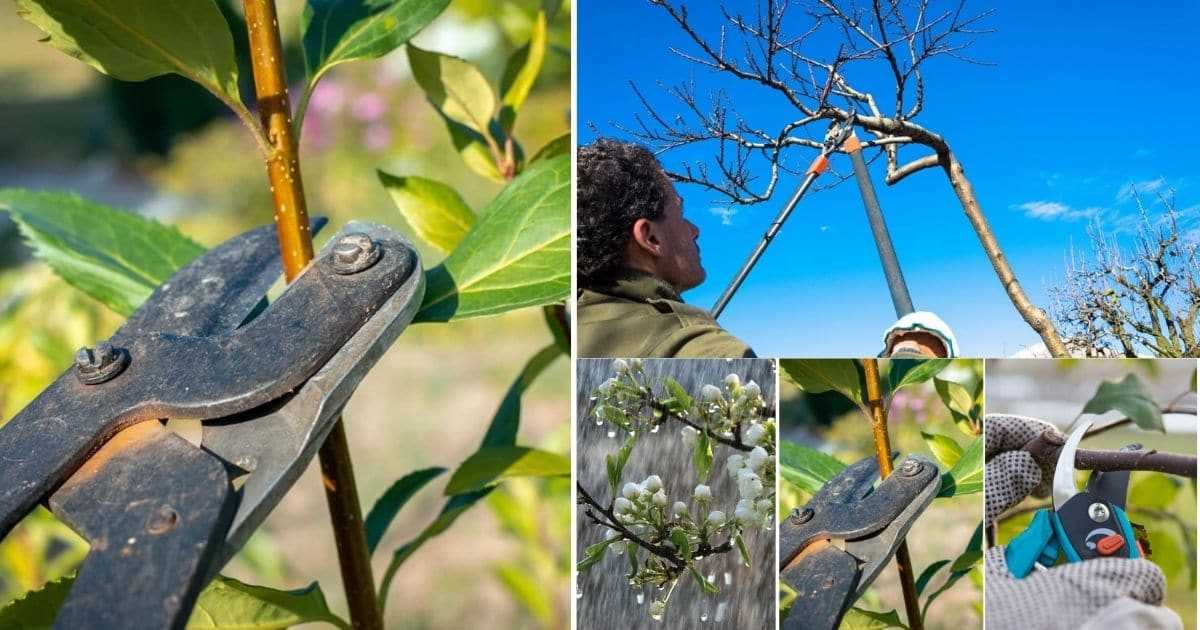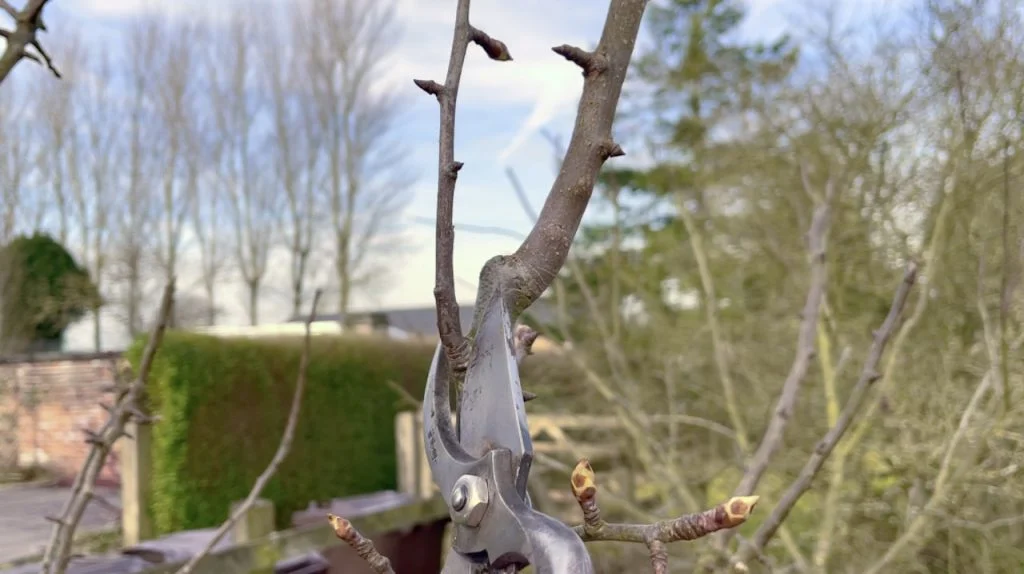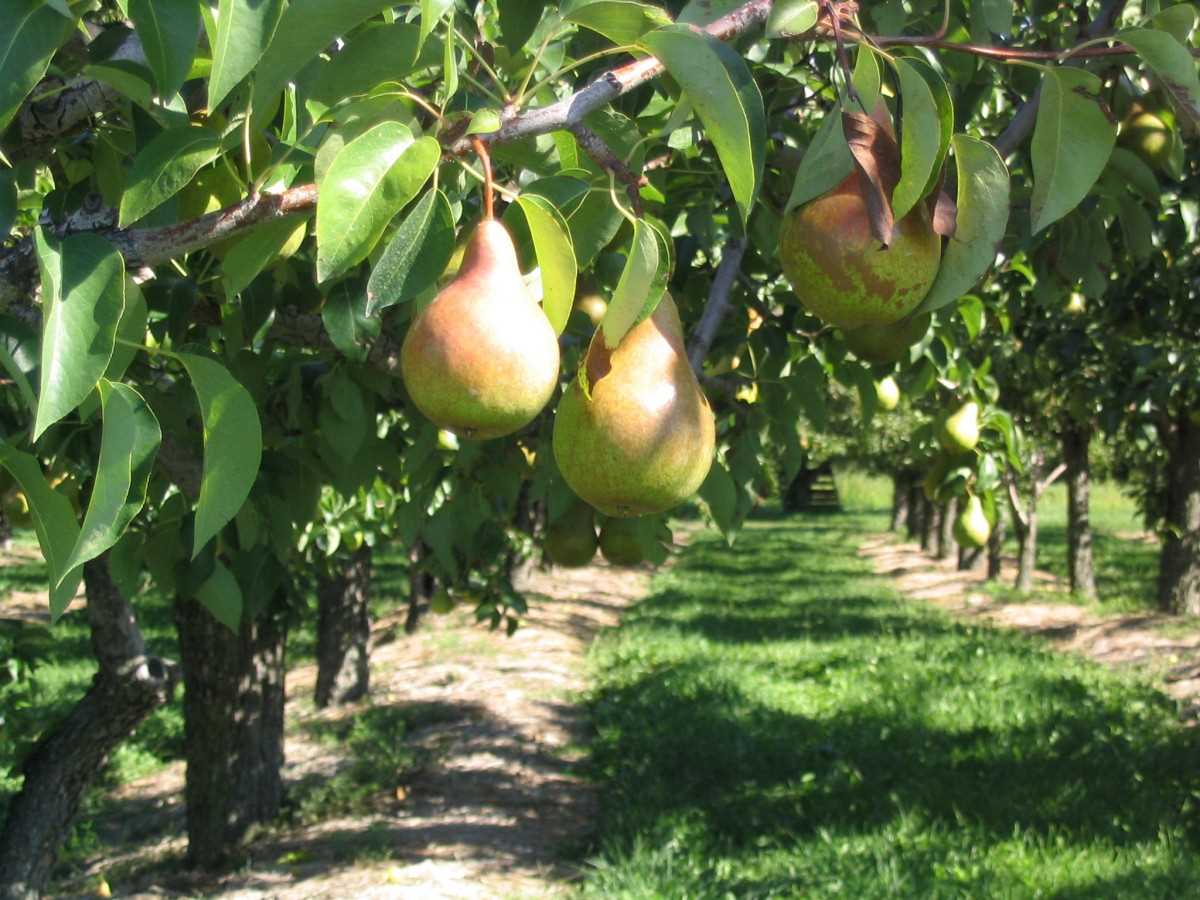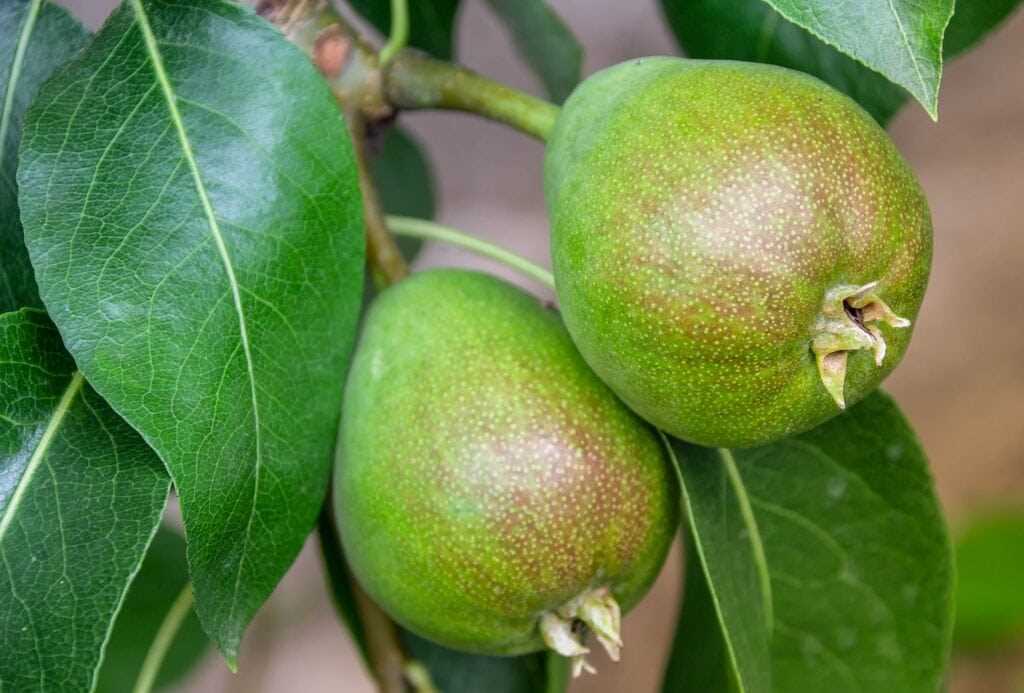- Mistake #1: Improper Timing of Pruning
- Mistake #2: Incorrect Pruning Techniques
- Mistake #3: Overpruning
- The Consequences of Overpruning
- How to Avoid Overpruning
- The Importance of Understanding the Growth Habit of Pear Trees
- Growth Habit of Pear Trees
- Pruning Techniques for Pear Trees
- The Consequences of Pruning Mistakes on Pear Trees
- 1. Reduced Fruit Production
- 2. Increased Susceptibility to Diseases and Pests
- 3. Structural Weakness and Damage
- 4. Loss of Vigor
- 5. Poor Aesthetic Appeal
- Steps to Avoid Mistakes in Pruning Pear Trees
- 1. Learn the Basics of Pruning
- 2. Observe the Tree’s Growth Patterns
- 3. Use Proper Pruning Tools
- 4. Start with the Three D’s
- 5. Thin Out Overcrowded Branches
- 6. Maintain the Tree’s Shape
- 7. Prune at the Right Time of Year
- 8. Take It Slow and Assess Regularly
- 9. Seek Professional Advice if Needed
- Pruning Pear Trees in the Correct Season
- Why is it important to prune pear trees in the correct season?
- When is the correct season for pruning pear trees?
- How to prune pear trees in the correct season?
- Consulting an expert
- Selecting and Using the Right Pruning Tools for Pear Trees
- 1. Pruning Shears:
- 2. Loppers:
- 3. Pruning Saw:
- 4. Pole Pruner:
- 5. Pruning Sealer:
- Question-answer:
- What are the three main mistakes in pruning?
- How can I avoid making the mistake of not understanding the growth habit of the plant?
- What are the consequences of over-pruning?
- When is the best time to prune pear trees?
- How much should I prune off a pear tree at a time?
- Video: How to Prune Pear Trees That Have Become Too Overgrown
Pruning is an essential practice in the maintenance of fruit trees, including pear trees. When done correctly, pruning can promote healthy growth, improve fruit production, and maintain the overall shape and structure of the tree. However, there are common mistakes that many gardeners make when pruning pear trees.
One of the main mistakes is improper timing. Pruning should be done during the dormant season, which is typically in late winter or early spring before buds start to break. Pruning outside of this period can lead to excessive sap flow and potential damage to the tree. Additionally, pruning during the growing season can disrupt the tree’s natural growth cycles and hinder fruit production.
Another mistake often made is over-pruning. It can be tempting to remove a large number of branches in an attempt to shape the tree or increase fruit production. However, excessive pruning can stress the tree and weaken its overall structure. It is important to strike a balance between removing necessary branches and maintaining the tree’s health and vitality.
The third mistake is the failure to properly identify and remove dead or diseased branches. Dead or diseased branches can negatively impact the overall health of the tree and reduce fruit production. It is crucial to regularly inspect the tree and remove any branches that show signs of disease or damage. Pruning these branches can help prevent the spread of disease and encourage new, healthy growth.
Mistake #1: Improper Timing of Pruning
One of the biggest mistakes that gardeners make when pruning pear trees is improper timing. Pruning at the wrong time of the year can negatively impact tree health and productivity.
Pear trees should be pruned during their dormant season, which is typically in late winter or early spring. Pruning during this time allows the tree to focus its energy on healing the wounds caused by pruning, rather than on growing new leaves or producing fruits.
Pruning too early in the winter can result in the tree being more susceptible to cold damage. On the other hand, pruning too late in the spring can disrupt the tree’s growth and inhibit the development of fruiting wood.
It’s also important to avoid pruning during periods of extreme temperature fluctuations or when the tree is stressed due to drought or disease. Pruning during these times can further weaken the tree and make it more susceptible to pests and diseases.
Therefore, it’s essential to familiarize yourself with the specific dormant period of your pear tree variety and plan your pruning accordingly. Consulting local gardening resources or seeking the advice of experienced gardeners can also help in determining the optimal time for pruning.
By avoiding the mistake of improper timing of pruning, you can promote the overall health and productivity of your pear tree, leading to a bountiful harvest.
Mistake #2: Incorrect Pruning Techniques
Pruning is an essential horticultural practice that helps maintain the health, shape, and productivity of the plants. However, using incorrect techniques while pruning can lead to a variety of problems. Here are some common mistakes to avoid:
- Over-pruning: Over-pruning occurs when too much of the plant is removed, resulting in weakened stems and reduced fruit production. It is important to understand the pruning requirements of each specific plant and avoid excessive removal.
- Bad timing: Timing is crucial when it comes to pruning. Pruning at the wrong time can disrupt the plant’s growth cycle and result in stunted growth or susceptibility to diseases. It is important to research and understand the appropriate time to prune each type of plant.
- Improper pruning cuts: Making improper cuts can create wounds that are slow to heal and can provide entry points for diseases and pests. It is essential to use sharp and clean pruning tools and make cuts at the correct angle and location, taking into consideration the plant’s natural growth habits.
By avoiding these common mistakes, you can ensure that your pruning efforts are effective and beneficial for your plants.
Mistake #3: Overpruning
Overpruning occurs when too many branches or buds are removed from a tree, resulting in excessive cutting. It is often driven by the desire to maintain a neat and tidy appearance, but it can have negative consequences for the overall health and growth of the tree.
The Consequences of Overpruning
When a tree is overpruned, it loses a significant amount of its foliage, which is essential for photosynthesis and the production of energy. This can weaken the tree and make it more vulnerable to diseases and pests. Additionally, overpruning can disrupt the natural balance of the tree, leading to an imbalance in its growth and development.
Overpruning can also lead to the production of an excessive number of water sprouts or suckers. These are weak, fast-growing branches that emerge from the tree trunk or main branches in response to the stress caused by overpruning. While it may seem counterintuitive, these water sprouts are actually a sign of stress and can further weaken the tree’s structure.
How to Avoid Overpruning
To avoid overpruning, it is important to have a clear understanding of the tree’s natural growth patterns and pruning requirements. By following these guidelines, you can help maintain the health and vitality of your tree:
- First, assess the overall health and structure of the tree. Identify any dead, damaged, or diseased branches that need to be removed.
- Next, determine the specific pruning objectives. Are you trying to shape the tree, thin out branches, or remove any potential hazards?
- When making cuts, follow the proper pruning techniques. Use sharp, clean tools and make clean, angled cuts just outside the branch collar. Avoid cutting too close or leaving long stubs.
- Avoid removing more than 25% of the tree’s foliage in a single pruning session. Spread out the pruning over several seasons to minimize stress on the tree.
- Regularly monitor the tree for any signs of stress or disease. If you notice any issues, consult a professional arborist to provide proper advice and care.
| Signs | Description |
|---|---|
| Excessive water sprouts or suckers | Weak, fast-growing branches that emerge from the trunk or main branches |
| Diseased or dying branches | Branches with discoloration, cankers, or other signs of disease |
| Overall decline in tree health | Reduced growth, leaf yellowing, or wilting |
| Unbalance in tree structure | One side of the tree being denser or bigger than the other |
By avoiding overpruning and following proper pruning practices, you can ensure the long-term health and beauty of your tree.
The Importance of Understanding the Growth Habit of Pear Trees
- Pear trees are known for their unique growth habit, and understanding this habit is crucial for successful pruning.
- Proper pruning of pear trees can not only ensure healthy growth and optimal fruit production but also prevent structural problems and disease susceptibility.
Growth Habit of Pear Trees
Pear trees typically have an upright growth habit with a central leader and lateral branches. Understanding the growth habit helps in determining which branches to prune and how to shape the tree.
Central Leader: The central leader is the main vertical stem of the tree. It plays a crucial role in providing structural support to the tree and should be preserved during pruning. Pruning should focus on removing competing branches or branches that are crossing or rubbing against the central leader.
Lateral Branches: Lateral branches grow horizontally from the central leader. These branches bear fruit and should be pruned to maintain the balance between vegetative growth and fruit production. Removing excessive lateral branches can help improve air circulation and sunlight penetration, reducing the risk of diseases such as fungal infections.
Pruning Techniques for Pear Trees
When pruning pear trees, it is important to follow the ABC rule. This rule states that pruning cuts should be Above a bud, Beyond a bud, and Comfortable for the pruner.
- Above a bud: Pruning cuts should be made just above a healthy, outward-facing bud. This encourages the growth of new shoots and prevents the growth of inward-facing branches that can cause congestion and reduce air circulation.
- Beyond a bud: Pruning cuts should be made beyond the bud, leaving a short stub. This prevents the bud from drying out and encourages the growth of new shoots.
- Comfortable for the pruner: Pruning cuts should be made at a comfortable height and angle for the person pruning the tree. This ensures safety and accuracy while pruning.
Overall, understanding the growth habit of pear trees is crucial for proper pruning. By following proper pruning techniques and considering the unique growth habit of pear trees, one can ensure the health, productivity, and longevity of these beautiful trees.
The Consequences of Pruning Mistakes on Pear Trees

Pruning is an important practice in pear tree care, as it helps shape the tree, controls its size, and promotes healthy growth. However, when done incorrectly, pruning can have negative consequences on the tree’s overall health and productivity. Here are some of the consequences of pruning mistakes on pear trees:
1. Reduced Fruit Production
One of the main purposes of pruning is to stimulate fruit production. When pruning is done incorrectly, such as excessive pruning or improper timing, it can result in reduced fruit production. Removing too many branches or cutting them at the wrong time can disturb the tree’s natural balance and prevent it from setting fruit properly.
2. Increased Susceptibility to Diseases and Pests

Pruning cuts create wounds on the tree, which can serve as entry points for diseases and pests. If pruning cuts are made incorrectly, leaving large stubs or creating rough and jagged edges, it can take longer for the wounds to heal. This extended healing time increases the tree’s vulnerability to infections and infestations, which can severely affect its overall health.
3. Structural Weakness and Damage
Improper pruning techniques, such as topping or heading back the main branches, can result in structural weakness in the tree. Removing too many branches or cutting them too close to the trunk can disrupt the tree’s natural growth pattern and lead to the development of weak branch attachments. These weak attachments are prone to breakage, especially during strong winds or heavy fruit loads, causing potential damage to the tree and its surroundings.
4. Loss of Vigor

Pruning mistakes can also lead to a loss of vigor in pear trees. When the tree’s branches are pruned excessively or incorrectly, it can hinder the tree’s ability to photosynthesize and produce food. This can result in a decline in overall health, reduced growth, and weakened resistance to environmental stressors.
5. Poor Aesthetic Appeal
Pruning mistakes can negatively impact the aesthetic appeal of pear trees. Over-pruning or uneven pruning can lead to a lopsided or unbalanced appearance, detracting from the tree’s natural beauty. Additionally, improper pruning can result in the growth of excessive water sprouts, which are fast-growing, weak branches that take away from the tree’s overall appearance.
| Consequence | Description |
|---|---|
| Reduced Fruit Production | Incorrect pruning can lead to a decrease in fruit production. |
| Increased Susceptibility to Diseases and Pests | Pruning mistakes create entry points for diseases and pests. |
| Structural Weakness and Damage | Improper pruning can result in weak branch attachments and potential breakage. |
| Loss of Vigor | Pruning mistakes can cause a decline in the tree’s overall health and growth. |
| Poor Aesthetic Appeal | Incorrect pruning can lead to an unbalanced or unsightly tree appearance. |
Steps to Avoid Mistakes in Pruning Pear Trees
1. Learn the Basics of Pruning
Before you begin pruning your pear trees, it’s important to understand the basics of pruning. This includes learning about the different types of cuts, understanding the growth habits of pear trees, and knowing when and how to prune for optimal tree health and fruit production.
2. Observe the Tree’s Growth Patterns
Take the time to observe your pear tree’s growth patterns before you start pruning. Look for branches that are crossing or rubbing against each other, branches that are growing towards the center of the tree, and any dead or diseased branches. By identifying these issues, you can prioritize which branches to prune and how to shape the tree properly.
3. Use Proper Pruning Tools
Using the right tools for the job is crucial when it comes to pruning pear trees. Make sure you have sharp, high-quality pruning shears, loppers, and a pruning saw if necessary. Dull or improper tools can cause damage to the tree and make pruning more difficult.
4. Start with the Three D’s
The three D’s of pruning – dead, damaged, and diseased – should be your first priority when pruning pear trees. Begin by removing any dead, broken, or diseased branches. This will help improve the overall health of the tree and prevent the spread of disease.
5. Thin Out Overcrowded Branches
Pear trees tend to have a lot of small, closely spaced branches that can lead to overcrowding. To avoid this, selectively remove some of the smaller, weaker branches to allow for better airflow and light penetration. This will promote healthy growth and reduce the risk of disease.
6. Maintain the Tree’s Shape
Pruning can also help maintain the desired shape and size of your pear tree. This involves selectively pruning branches that are growing in the wrong direction, crowding the center of the tree, or interfering with other branches. Proper shaping will improve the tree’s overall structure and make it easier to manage in the future.
7. Prune at the Right Time of Year
Timing is key when it comes to pruning pear trees. The best time to prune is during the dormant season, typically in late winter or early spring before new growth begins. Pruning during this time will minimize stress on the tree and allow it to heal properly before the growing season.
8. Take It Slow and Assess Regularly
Pruning should be approached with patience and care. Take your time when making cuts and regularly step back to assess the tree’s overall shape and balance. This will help you make more informed pruning decisions and avoid over-pruning or damaging the tree.
9. Seek Professional Advice if Needed
If you feel unsure about pruning your pear tree or have a complex pruning issue, it’s always a good idea to seek professional advice. Arborists or horticulturists can provide guidance specific to your tree and help you avoid making costly mistakes.
By following these steps, you can avoid common mistakes and effectively prune your pear tree for improved health and a bountiful harvest.
Pruning Pear Trees in the Correct Season
Why is it important to prune pear trees in the correct season?
Pruning pear trees at the right time is crucial for their overall health and productivity. It helps to maintain the desired shape, control the size of the tree, improve air circulation, and increase fruit quality and yield. Pruning at the wrong time can lead to negative consequences such as excessive bleeding, increased vulnerability to diseases, and reduced fruit production.
When is the correct season for pruning pear trees?
The ideal time for pruning pear trees is during their dormant period, which typically occurs in late winter or early spring, before new growth emerges. This stage is ideal because the tree is not actively growing, allowing it to heal more quickly and minimize the risk of infection. Pruning during the dormant season also allows the tree to prioritize energy towards healing wounds and developing new growth, resulting in healthier and more productive trees.
How to prune pear trees in the correct season?
Here are some general guidelines to follow when pruning pear trees during the correct season:
- Start by removing any dead, damaged, or diseased branches, as they can be a source of infection and hinder the tree’s growth.
- Identify and remove any branches that are crossing or rubbing against each other. This will help maintain an open structure and prevent damage.
- Thin out crowded areas by pruning selected branches to promote better air circulation and light penetration.
- Trim back excessive growth, especially on the top and sides of the tree, to maintain a balanced shape and control the size.
- When making cuts, use sharp and clean pruning tools to ensure smooth cuts and minimize the risk of infection.
- Lastly, clean up and dispose of any pruned branches and debris to prevent the spread of diseases.
Consulting an expert
If you are unsure about how or when to prune your pear trees, it is always a good idea to consult with a professional arborist or horticulturist. They can provide personalized advice and guidance based on the specific needs and conditions of your pear trees.
Selecting and Using the Right Pruning Tools for Pear Trees
Proper pruning techniques are essential for maintaining the health and productivity of pear trees. To successfully prune your pear trees, it is important to have the right tools at your disposal. Here are some tips for selecting and using the right pruning tools:
1. Pruning Shears:
Pruning shears, also known as secateurs, are a must-have tool for any gardener. When pruning pear trees, it is important to choose a pair of shears that are sharp, clean, and of high quality. This will ensure clean cuts and minimize the risk of injuring the tree. Look for pruning shears with a bypass cutting action, as they provide a clean and precise cut without crushing the branches.
2. Loppers:

Loppers are especially useful for pruning thick or hard-to-reach branches. When choosing loppers for pear tree pruning, opt for a pair with long handles to provide leverage and reach. Look for loppers with sharp, bypass blades for clean cuts. It is also important to select loppers that are comfortable to use and fit your hand well, as pruning can be a physically demanding task.
3. Pruning Saw:
A pruning saw is essential for cutting larger branches that cannot be pruned with shears or loppers. When selecting a pruning saw for pear tree pruning, choose one with a curved blade and aggressive teeth for efficient cutting. It is important to maintain the sharpness of the saw blade and clean it after each use to prevent the spread of diseases.
4. Pole Pruner:
A pole pruner is a handy tool for reaching and pruning branches that are high up in the tree. It consists of a pruning saw attached to a long pole, allowing you to reach higher branches without the need for a ladder. Look for a pole pruner with a telescopic handle for adjustable reach. Make sure to use the pole pruner with caution and follow safety guidelines to prevent accidents.
5. Pruning Sealer:
While not a pruning tool per se, a pruning sealer can be a useful addition to your pruning routine. After making cuts on larger branches, applying a pruning sealer can help prevent the entry of pathogens and promote faster healing. Choose a pruning sealer that is specifically formulated for tree pruning and follow the instructions for optimal results.
Remember, using the right tools and following proper pruning techniques are crucial for the health and productivity of your pear trees. Regular pruning will help maintain the shape, vigor, and fruit production of your trees. Take your time, be patient, and enjoy the process of pruning your pear trees.
Question-answer:
What are the three main mistakes in pruning?
The three main mistakes in pruning are not understanding the growth habit of the plant, over-pruning, and improper timing of pruning.
How can I avoid making the mistake of not understanding the growth habit of the plant?
To avoid this mistake, it is important to research and understand the specific growth habits of the plant you are pruning. This can include learning about where and how the plant produces new growth, how it flowers, and how it responds to pruning.
What are the consequences of over-pruning?
Over-pruning can have negative effects on the health and appearance of the plant. It can weaken the plant, reduce its ability to produce flowers and fruit, and make it more susceptible to diseases and pests.
When is the best time to prune pear trees?
The best time to prune pear trees is during late winter or early spring, before the new growth starts. Pruning during this time allows the tree to heal more quickly and reduces the risk of disease or pest infestation.
How much should I prune off a pear tree at a time?
When pruning a pear tree, it is recommended to only remove up to 25-30% of the tree’s total canopy each year. Removing too much can shock the tree and inhibit its ability to produce fruit.







